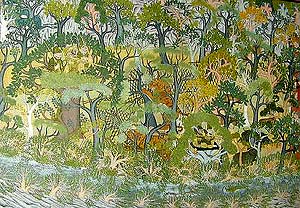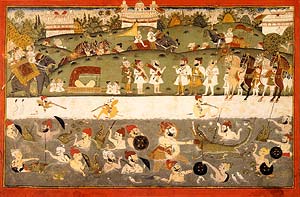| The Realm of Kings | The Hunt | Court Life | Kings, Courtiers, and Women | Courtly Manuscripts | The Realm of Gods | |||||||||

Hansraj Joshi
A tiger hunt Kotah, Rajasthan; dated 1777 Opaque watercolor and gold on paper Cynthia Hazen Polsky Collection (2086-IP)

Prince Ishvari Singh hunting crocodile
Uniara or Southern Jaipur region, Rajasthan; mid-18th century Opaque watercolor on paper Max Polsky Collection (3090-IP) |
The Hunt Hunting has always been the sport of kings as well as a substitute or training for warfare. In the time of Akbar (1556–1605), great hunts, sometimes lasting for days, were conducted on a grandiose military scale. Contemporary paintings show that the bold and energetic emperor participated in this carnage with gusto. Many kinds of hunting were popular under the Mugal rulers, including hunting deer with trained cheetahs. For the Hindu Rajputs, hunting (shikar) had an even stronger ritualistic social importance. The coming of spring was celebrated with a royal hunt for wild boar, which, if successful, would be a good omen for the coming year. Game of every kind was pursued by the Rajputs, but killing a tiger was a royal prerogative seldom granted to others. Depictions of tiger hunts in dense forests by eighteenth-century Kotah artists are among the most powerful of Indian hunting pictures. The most detailed and comprehensive shikar scenes were those of the Udaipur painters, who maintained an almost continuous pictorial record of royal hunts, from the early 1700s until as late as the 1940s. |